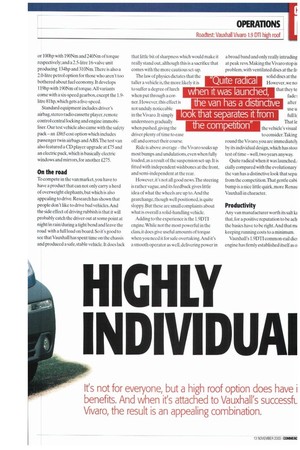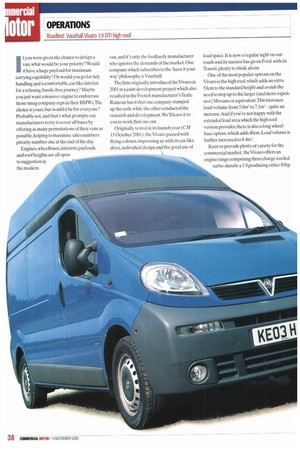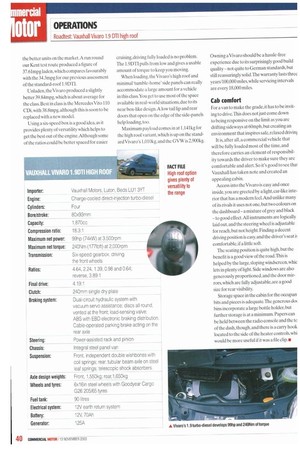11G1111.1' 1 1•11:11V11:111it
Page 39

Page 38

Page 40

If you've noticed an error in this article please click here to report it so we can fix it.
It's not for everyone, but a high roof option does have i benefits. And when it's attached to Vauxhall's successfL Vivaro, the result is an appealing combination.
If you were given the chance to design a van,what would be your priority? Would it have a huge payload for maximum carrying capability? Or would you go for tidy handling and a comfortable, car-like interior for a relaxing, hassle-free journey? Maybe you just want a massive engine to embarrass those smug company reps in their BMWs. The choice is yours, but would it be for everyone? Probably notand that's what prompts van manufacturers to try to cover all bases by offering as many permutations of their vans as possible, helping to maximise sales numbers: priority number one at the end of the day Engines, wheelbases, interiors.payloads and roof heights are all open to suggestion in the modern van, and it's only the foolhardy manufacturer who ignores the demands of the market. One company which subscribes to the 'have it your way' philosophy is Vauxhall.
The firm originally introduced the Vivaro in 2001 in a joint development project which also resulted in the French manufacturesTrafic. Rumour has it that one company stumped up the cash.while the other conducted the research and development. We'll leave it to you to work that one out.
Originally tested in its launch year (CM 13 October 2001). the Vivaro passed with flying colours. impressing us with its car-like drive, individual design a d the good use of load space. It is now a regular sight on our roads and its success has given Ford, with its Transit, plenty to think about.
One of the most popular options on the Vivaro is the high roof, which adds an extra 53crn to the standard height and avoids the need to step up to the larger (and more expensive) Movano or equivalent.This increases load-volume from 5.0m3 to 7.1m-' —quite an increase.And if you're not happy with the extended load area which the high roof version provides, there is also a long wheelbase option, which adds 40cm. Load volume is further increased to 8.4m3.
Keen to provide plenty of variety for the commercial market, the Vivaro offers an engine range comprising three charge-cooled turbo-diesels: a 1.9 producing either 81hp or 100hp with 190Nm and 240Nm of torque respectively; and a 2.5-litre 16-valve unit producing 134hp and 310Nm.There is also a 2.0-litre petrol option for those who aren't too bothered about fuel economy. It develops 119hp with 190Nm of torque. All variants come with a six-speed gearbox, except the 1.9litre 81hp, which gets a five-speed.
Standard equipment includes driver's airbag, stereo radio cassette player, remote control central locking and engine immobiliser. Our test vehicle also came with the safety pack -an 1.865 cost option which includes passenger twin airbags and ABS.The test van also featured a CD player upgrade at £75 and an electric pack, which is basically electric windows and mirrors,for another £275.
On the road To compete in the van market,you have to have a product that can not only carry a herd of overweight elephants, but which is also appealing to drive. Research has shown that people don't like to drive bad vehicles, And the side effect of driving rubbish is that it will probably catch the driver out at some point at night/in rain/during a tight bend and leave the road with a full load on board. So it's good to see that Vauxhall has spent time on the chassis and produced a safe, stable vehicle. It does lack that little bit of sharpness which would make it really stand out, although this is a sacrifice that comes with the more cautious set-up.
The law of physics dictates that the taller a vehicle is,the more likely it is to suffer a degree of lurch when put through a corner. However, this effect is not unduly noticeable in the Vivaro. It simply understeers gradually when pushed. giving the driver plenty of time to ease off and correct their course.
Ride is above average the Vivaro soaks up most bumps and undulations,even when fully loaded, as a result of the suspension set-up. It is fitted with independent wishbones at the front, and semi-independent at the rear.
However,it's not all good news.The steering is rather vague, and its feedback gives little idea of what the wheels are up to. And the gearchange, though well positioned, is quite sloppy. But these are small complaints about what is overall a solid-handling vehicle.
Adding to the experience is the 1.9DT1 engine. While not the most powerful in the class, it does give useful amounts of torque when you need it for safe overtaking. And it's a smooth operator as well, delivering power in a broad band and only really intruding at peak revs. Making the Vivaro stop is problem, with ventilated discs at the fr solid discs at the However, we no that they te fade after use u full lc That le the vehicle's visual to consider.Taking round the Vivaro, you are inunediatel) by its individual design, which has stoo test of time well, two years anyway.
Quite radical when it was launched,+ cially compared with the evolutionary the van has a distinctive look that sepal from the competition.That gentle cahi bump is a nice little quirk. more Renau Vauxhall in character.
Productivity An van manufacturer worth its salt ki that, for a positive reputation to be ach the basics have to be right. And that rri( keeping running costs to a minimum.
Vauxhall's 1.9DTI common-rail die. engine has firmly established itself as o the better units on the market.A run round our Kent test route produced a figure of 37.61mpg laden, which compares favourably with the 34.3mpg for our previous assessment of the standard-roof 1.9DTI.
Unladen, the Vivaro produced a slightly better 39.84mpg. which is about average for the class. Best in class is the Mercedes Vito 110 CDi. with 38.8mpg. although this is soon to be replaced with a new model.
Using a six-speed box is a good idea, as it provides plenty of versatility which helps to get the best out of the engine. Although some of the ratios could be better spaced for easier cruising, driving fully loaded is no problem. The 1.9DTI pulls from low and gives a usable amount of torque to keep you moving.
When loading,the Vivaro's high roof and minimal 'tumble-home' side panels can really accommodate a large amount for a vehicle in this class. You get to use most of the space available in real-world situations, due to its near box-like design.A low tail lip and rear doors that open on the edge of the side-panels help loading, too.
Maximum payload comes in at 1,141kg for the high roof variant,which is up on the standard Vivaro's 1.010kg. and the GVW is 2.900kg. Owning aVivaro should be a hassle-free experience due toils surprisingly good build quality —not quite to German standards, but still reassuringly solid.The warranty lasts three years/100,000 miles, while servicing intervals are every 18,000 miles.
Cab comfort
For a van to make the grade. it has to be inviting to drive.This does not just come down to being responsive on the limit as you are drifting sideways at 60mph,but creating an environment that inspires safe, relaxed drivini It is, after all, a commercial vehicle that will be fully loaded most of the time, and therefore carries an element of responsibility towards the driver to make sure they are comfortable and alert. So it's good to see thai Vauxhall has taken note and created an appealing cabin.
Access into the Vivaro is easy and once inside, you are greeted by a light, car-like interior that has a modern feel.And unlike many of its rivals it uses not one, but two colours on the dashboard —a mixture of grey and black — to good effect.All instruments are logically laid out,and the steering wheel is adjustable for reach,but not height. Finding a decent driving position is easy and the driver's seat comfortable, if a little soft.
The seating position is quite high,but the benefit is a good view of the road.This is helped by the large,sloping windscreen, whic lets in plenty of light. Side windows are also generously proportioned. and the door mirrors, which are fully adjustable,are a good size for rear visibility.
Storage space in the cabin for the occupan bits and pieces is adequate.The generous doc bins incorporate a large bottle holder, but further storage is at a minimum. Papers can be held between the radio console and the tc of the dash, though,and there is a carry hook located to the side of the heater controls, whi would be more useful if it was a file clip.•
































































































































































































